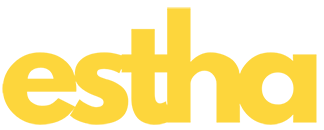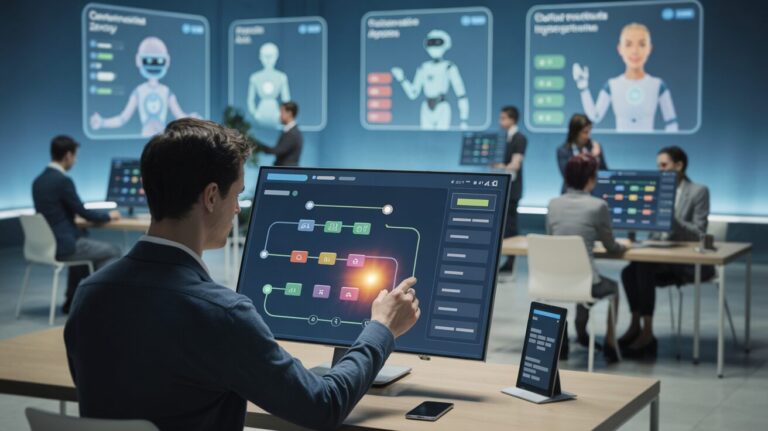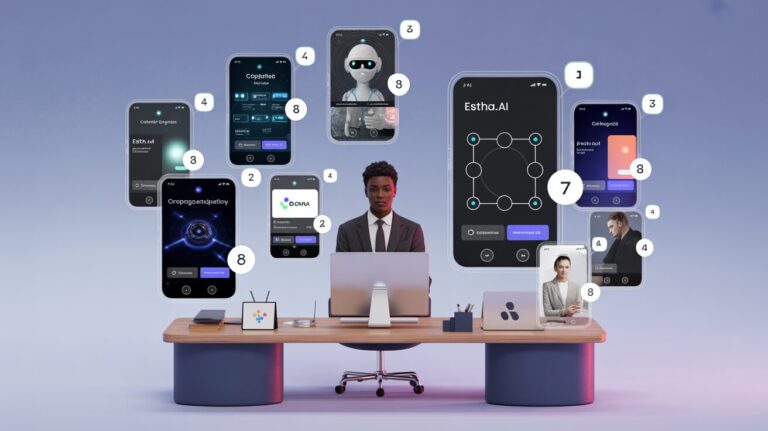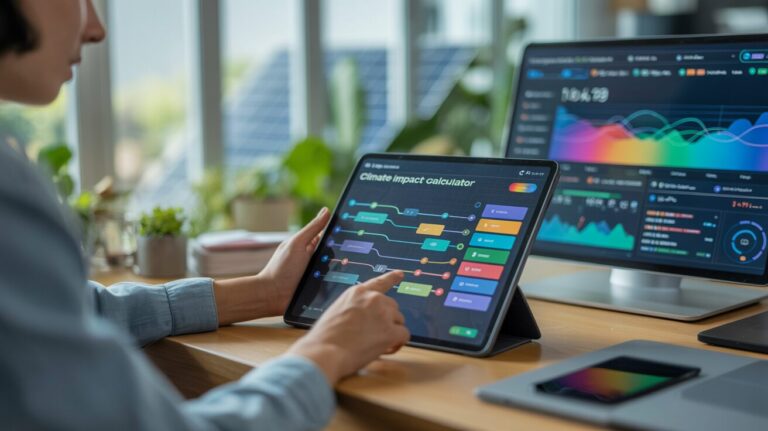Table Of Contents
- Introduction
- Understanding HR Onboarding Chatbots
- Benefits of HR Onboarding Chatbots
- Essential Components of an Effective HR Onboarding Chatbot
- HR Onboarding Chatbot Flow Template
- Customizing Your HR Onboarding Chatbot
- Implementing Your HR Onboarding Chatbot with Estha
- Measuring Success
- Common Challenges and Solutions
- Conclusion
HR Onboarding Chatbot Flow Template: Streamline Your New Hire Process
The first days and weeks at a new job are crucial for employee engagement and retention. Yet, traditional onboarding processes often overwhelm new hires with information while simultaneously burdening HR teams with repetitive tasks. What if there was a way to make onboarding more interactive, personalized, and efficient? Enter HR onboarding chatbots—AI-powered assistants that are transforming how companies welcome new employees.
In this comprehensive guide, we’ll explore how HR onboarding chatbots can revolutionize your employee experience from day one. We’ll provide a practical HR onboarding chatbot flow template that you can implement using Estha’s no-code AI platform, allowing you to build a customized solution in minutes—no technical expertise required. By the end of this article, you’ll understand how to create an engaging, informative, and efficient onboarding experience that sets your new hires up for success while saving your HR team valuable time.
HR Onboarding Chatbot Blueprint
Transform your employee onboarding with Estha’s no-code AI platform
24/7 Support
Provide instant answers to new hire questions anytime, eliminating wait times during critical first days.
Time Savings
HR professionals spend up to 50% less time answering repetitive questions, focusing instead on strategic activities.
Key Benefits
Faster time to full productivity
Higher new hire retention rates
Reduced information overload
10-Step HR Onboarding Chatbot Flow
1. Welcome & Introduction
Personalized greeting and purpose setting
2. Needs Assessment
Identifying what new hire needs most
3. Documentation
Guiding through required paperwork
4. Benefits & Policies
Explaining company offerings clearly
5. Tech Setup
Ensuring access to necessary tools
6. Team Introduction
Meeting colleagues and understanding org structure
7. First Week Schedule
Outlining activities and expectations
8. Regular Check-ins
Daily support and progress tracking
9. Feedback Collection
Gathering insights on the experience
10. Escalation Process
Connecting with HR when needed
Implementation with Estha in 4 Easy Steps
Start with HR Template
Begin with Estha’s pre-built HR onboarding template for a quick start.
Customize with Drag-Drop-Link
Modify the template with Estha’s intuitive interface to match your processes.
Test and Refine
Test each conversation path and refine based on feedback from early users.
Deploy Across Channels
Launch on your intranet, mobile app, email, or communication platforms.
Track Your Onboarding Success
Engagement Metrics
- Adoption Rate
- Conversation Depth
- Completion Rate
Efficiency Metrics
- Time to Completion
- HR Time Saved
- Escalation Rate
Satisfaction Metrics
- Employee Feedback
- Net Promoter Score
- Retention Impact
Transform Your Onboarding Today
Create a custom HR onboarding chatbot in minutes with Estha’s no-code AI platform. No technical expertise required.
Understanding HR Onboarding Chatbots
HR onboarding chatbots are interactive AI assistants designed to guide new employees through the onboarding process. These virtual assistants use conversational interfaces to provide information, answer questions, collect required data, and direct new hires to relevant resources—all available 24/7.
Unlike static onboarding documents or portals, chatbots engage employees in natural conversation, creating a more dynamic and personalized experience. They can adapt their responses based on an employee’s role, department, location, and specific needs, making the information immediately relevant to each individual.
Modern HR onboarding chatbots aren’t just simple FAQ tools. Advanced solutions built with platforms like Estha can guide employees through complex processes, schedule training sessions, introduce team members, explain company policies, and even help with practical matters like setting up workstations or requesting equipment.
Benefits of HR Onboarding Chatbots
Implementing an HR onboarding chatbot delivers multiple advantages for both new employees and your organization:
For New Employees
24/7 Support: New hires can get answers to their questions anytime, eliminating the frustration of waiting for responses during their critical first days.
Reduced Information Overload: Instead of receiving all information at once, employees can access exactly what they need when they need it, improving information retention.
Consistent Experience: Every new hire receives the same high-quality information and guidance, regardless of when they join or who’s available to assist them.
Self-paced Learning: Employees can progress through onboarding materials at their own pace, revisiting important information as needed.
For HR Teams
Time Savings: HR professionals spend up to 50% less time answering repetitive questions, allowing them to focus on more strategic activities.
Reduced Administrative Burden: Chatbots can collect and process new hire information, track completion of onboarding tasks, and send reminders automatically.
Improved Completion Rates: Organizations using onboarding chatbots report higher completion rates for required documentation and training.
Better Data Collection: Chatbots gather valuable feedback about the onboarding process, helping HR teams continuously improve their programs.
For the Organization
Faster Time to Productivity: Employees who receive effective onboarding reach full productivity up to 25% faster than those who don’t.
Increased Retention: Companies with structured onboarding programs experience 50% higher new hire retention rates.
Cost Efficiency: Automated onboarding reduces costs associated with manual processes and improves resource allocation.
Enhanced Employer Brand: A modern, tech-forward onboarding experience reflects positively on your company culture and employer brand.
Essential Components of an Effective HR Onboarding Chatbot
Before diving into our template, let’s understand the key elements that make an HR onboarding chatbot truly effective:
Personalized Welcome
Your chatbot should greet new employees by name and acknowledge their specific role and team. This personalized touch immediately makes new hires feel recognized and valued. The welcome message should set a friendly, supportive tone that reflects your company culture.
Needs Assessment
An effective chatbot begins by understanding what the new employee needs most. This could involve asking about their familiarity with certain systems, what information they’re looking for, or what tasks they need to complete next. This assessment helps tailor the conversation to provide the most relevant assistance.
Information Delivery
Your chatbot should provide clear, concise information about company policies, benefits, team structures, and workplace procedures. The best chatbots break this information into digestible chunks rather than overwhelming users with text. They also incorporate various media formats like videos, images, and links to relevant documents.
Task Guidance
Onboarding involves completing numerous tasks, from filling out tax forms to setting up accounts. Your chatbot should guide employees through these processes step-by-step, explaining each requirement and directing them to the appropriate resources or platforms.
FAQ Handling
New employees typically have many questions during onboarding. Your chatbot should be equipped to answer common queries about work hours, dress code, parking, equipment, team members, and other frequently asked questions.
Escalation Paths
When the chatbot can’t resolve an issue or answer a question, it should have clear escalation paths to human HR team members. This ensures new hires never feel stuck or frustrated when they need additional support.
Feedback Collection
Your chatbot should periodically ask for feedback on both the onboarding process and the chatbot experience itself. This information is invaluable for improving your onboarding program and the chatbot’s functionality.
HR Onboarding Chatbot Flow Template
Now, let’s explore a comprehensive template for an HR onboarding chatbot flow that you can build using Estha’s no-code AI platform. This template provides a starting point that you can customize to fit your organization’s specific needs.
1. Welcome and Introduction Flow
Initial Greeting: “Hello [Employee Name]! Welcome to [Company Name]. I’m your onboarding assistant, here to help make your first few weeks as smooth as possible.”
Purpose Statement: “I’m here to help you complete your onboarding tasks, answer your questions about [Company Name], and connect you with the resources you need.”
Interaction Instructions: “You can ask me questions anytime, or select options from the menus I’ll provide. If you ever need to speak with a human from the HR team, just type ‘connect with HR.'”
2. Initial Needs Assessment Flow
Priority Check: “What would you like help with today?” – Complete required paperwork – Learn about benefits and policies – Set up my workstation/accounts – Meet my team – Understand my first week schedule – Something else (please describe)
Based on the selection, the chatbot branches to the relevant conversation flow.
3. Documentation Completion Flow
Status Check: “I see you need to complete the following documents:” – Employment eligibility verification (I-9) – [Status] – Tax withholding (W-4) – [Status] – Direct deposit authorization – [Status] – Benefits enrollment – [Status] – Employee handbook acknowledgment – [Status]
Document Guidance: For each incomplete document, the chatbot provides:
“Would you like to complete [Document Name] now?” – Yes → Provides link to document and step-by-step guidance – No → “No problem. When would you like a reminder to complete this?”
Completion Confirmation: “Great job completing [Document Name]! This has been recorded in our system.”
4. Benefits and Policies Flow
Topic Selection: “What would you like to learn more about?” – Health insurance – Retirement plans – PTO and leave policies – Workplace policies – Performance expectations – Learning and development – Company culture
Information Delivery: For each selection, provide concise, scannable information with links to detailed resources.
Follow-up: “Does that answer your question about [Topic]?” – Yes → “Great! What else would you like to know about?” – Partially → “What specific information are you looking for?” – No → Escalate to HR specialist
5. Technology Setup Flow
Setup Status: “Let’s make sure you have access to all the tools you need:” – Email account – [Status] – Laptop/computer – [Status] – Phone/communication tools – [Status] – Project management tools – [Status] – Department-specific software – [Status]
Issue Resolution: For any incomplete items:
“I notice you still need [Item]. Would you like help with this now?” – Yes → Provide setup instructions or create IT ticket – No → “When would you like a reminder about this?”
6. Team Introduction Flow
Team Overview: “Let me introduce you to your team at [Company Name].” – Display organizational chart with direct manager and team members – Provide brief bios of key team members
Connection Facilitation: “Would you like me to help schedule virtual coffee chats with your team members?” – Yes → Collect preferences and facilitate scheduling – No → “No problem! You can always come back to this option later.”
7. First Week Schedule Flow
Schedule Overview: “Here’s what your first week looks like:” – Day 1: [Scheduled activities] – Day 2: [Scheduled activities] – Day 3: [Scheduled activities] – Day 4: [Scheduled activities] – Day 5: [Scheduled activities]
Calendar Integration: “Would you like me to add these events to your work calendar?” – Yes → Process calendar integration – No → “You can always access this schedule here in our chat.”
8. Regular Check-in Flow
Daily Check-in: “Good morning, [Employee Name]! How are you settling in today?” – Great → “Wonderful! Is there anything specific you’d like help with today?” – OK → “Is there anything I can help with to make things better?” – Struggling → Offer specific support options or escalate to HR
Task Reminder: “Here are your pending onboarding tasks:” – [List of incomplete tasks with status and priority]
9. Feedback Collection Flow
Process Feedback: “How would you rate your onboarding experience so far on a scale of 1-5?” – Collect rating – “What aspects of onboarding have been most helpful?” – “What could we improve about the onboarding process?”
Chatbot Feedback: “How helpful have I been as your onboarding assistant on a scale of 1-5?” – Collect rating – “How could I better assist you?”
10. Escalation Flow
Escalation Trigger: When the chatbot cannot answer a question or when the user requests human assistance.
Escalation Process: – “I’d like to connect you with someone who can help with this.” – “Would you prefer: – Email response (typically within 4 hours) – Phone call (typically within 1 business day) – Live chat with HR (if available now)”
Handoff: “I’m connecting you with [HR Team Member]. They’ll be in touch [via selected method] [within expected timeframe].”
Customizing Your HR Onboarding Chatbot
While our template provides a comprehensive starting point, your HR onboarding chatbot should reflect your organization’s unique culture, processes, and needs. Here’s how to customize it effectively:
Align with Your Company Culture
Adjust the chatbot’s tone and language to match your company’s communication style. If your culture is formal, the chatbot should use professional language. If your workplace is casual, the chatbot can be more conversational and even incorporate appropriate humor.
Include company-specific terminology and references that will help new hires become familiar with your organization’s unique vocabulary. This helps them integrate more quickly into team conversations.
Tailor to Different Roles
Create role-specific branches in your chatbot flow to provide information relevant to different positions, departments, or locations. For example, a sales team member might need different resources than someone in engineering.
Consider creating separate onboarding paths for remote versus in-office employees, as their setup needs and integration processes may differ significantly.
Integrate with Your Systems
Connect your chatbot to your existing HR systems, such as your HRIS, document management system, or learning management system. This allows the chatbot to pull real-time data about the employee’s onboarding status and provide accurate information.
Ensure the chatbot can pass completed documentation and collected information back to your core systems to avoid creating data silos or requiring duplicate data entry.
Implementing Your HR Onboarding Chatbot with Estha
Building an HR onboarding chatbot used to require significant technical expertise or expensive vendor solutions. However, with Estha’s no-code AI platform, you can create a sophisticated chatbot in minutes, even if you have no coding experience. Here’s how:
Step 1: Start with the Right Foundation
Begin by selecting Estha’s HR Onboarding template as your starting point. This pre-built template includes many of the flows described above, giving you a substantial head start.
The template comes with pre-configured conversation paths, common onboarding questions, and task management flows that you can customize to your needs.
Step 2: Customize Your Chatbot
Using Estha’s intuitive drag-drop-link interface, modify the template to match your specific onboarding process. Add, remove, or edit conversation nodes to create the perfect flow for your organization.
Upload your company-specific information, including policies, benefits details, organizational charts, and process documentation. Estha’s AI will automatically process this information to answer employee questions accurately.
Personalize the chatbot’s appearance with your company logo and brand colors to create a seamless experience for your new hires.
Step 3: Test and Refine
Before launching your chatbot, thoroughly test each conversation path to ensure it provides accurate information and handles user inputs correctly. Estha’s testing environment allows you to simulate conversations and identify any issues.
Gather feedback from a small group of users, such as recent hires or HR team members, and refine the chatbot based on their input. Look for areas where the chatbot could provide clearer information or handle additional questions.
Step 4: Deploy Across Channels
With Estha, you can deploy your HR onboarding chatbot across multiple channels to meet employees where they are. Options include:
Company Intranet: Embed the chatbot directly in your company portal or intranet for easy access during the workday.
Mobile App: Offer the chatbot through a mobile interface for employees who prefer smartphone access.
Email Integration: Allow employees to interact with the chatbot directly through email for maximum convenience.
Communication Platforms: Integrate with tools like Slack or Microsoft Teams to provide onboarding support where employees already communicate.
Step 5: Monitor and Improve
Estha’s analytics dashboard provides insights into how employees are using your chatbot. Track common questions, completion rates for various tasks, and overall satisfaction scores.
Use this data to continuously improve your chatbot, adding new information to address frequently asked questions and refining conversation flows that may cause confusion.
Measuring Success
To ensure your HR onboarding chatbot is delivering value, establish clear metrics for success:
Engagement Metrics
Adoption Rate: The percentage of new hires who actively engage with the chatbot during onboarding.
Conversation Depth: The average number of interactions per session, indicating how thoroughly employees are using the chatbot.
Completion Rate: The percentage of onboarding tasks successfully completed through the chatbot versus other methods.
Efficiency Metrics
Time to Completion: How quickly employees complete their onboarding tasks compared to pre-chatbot processes.
HR Time Saved: The reduction in hours that HR staff spend on routine onboarding activities.
Escalation Rate: The percentage of inquiries that require human intervention, with lower rates indicating better chatbot performance.
Satisfaction Metrics
Employee Feedback: Direct ratings and comments from new hires about their experience with the chatbot.
Net Promoter Score: Whether employees would recommend your onboarding process to others.
Retention Impact: Correlation between chatbot usage and employee retention at 30, 60, and 90 days.
Common Challenges and Solutions
As you implement your HR onboarding chatbot, be prepared to address these common challenges:
Challenge: Employees Preferring Human Interaction
Solution: Make it clear that the chatbot is a complement to, not a replacement for, human support. Ensure the chatbot can easily connect employees with HR team members when needed, and consider a hybrid approach where certain critical conversations are still conducted in person or via video call.
Challenge: Information Accuracy and Updates
Solution: Establish a regular schedule for reviewing and updating chatbot content, especially after policy changes or organizational restructuring. Estha’s platform makes these updates easy with its centralized content management, allowing you to update information once and have it reflected across all chatbot interactions.
Challenge: Technical Integration Issues
Solution: Leverage Estha’s pre-built integrations with popular HR systems to streamline data flow between your chatbot and existing platforms. For custom integrations, Estha’s support team can provide guidance to ensure smooth connectivity without requiring deep technical knowledge.
Challenge: Low Adoption Rates
Solution: Introduce the chatbot early in the pre-boarding process with a clear explanation of its benefits. Create a brief tutorial showing how to use it effectively, and consider gamifying the experience by rewarding employees who complete certain milestones through the chatbot.
Conclusion
An effective HR onboarding chatbot can transform your employee experience from day one, providing personalized support while significantly reducing the administrative burden on your HR team. With the template and implementation guidance provided in this article, you have everything you need to create a chatbot that welcomes new hires, guides them through essential tasks, answers their questions, and helps them integrate smoothly into your organization.
The beauty of using Estha’s no-code AI platform is that you don’t need technical expertise to build a sophisticated HR onboarding solution. In just minutes, you can create a chatbot that reflects your unique processes and company culture, then deploy it across multiple channels to support your new hires wherever they are.
As the workforce continues to evolve, particularly with the growth of remote and hybrid work arrangements, AI-powered onboarding tools will become increasingly essential for creating consistent, engaging experiences for every employee. By implementing an HR onboarding chatbot now, you’re not just solving today’s challenges—you’re preparing your organization for the future of work.
Remember that your chatbot should evolve alongside your organization. Regularly review its performance, gather feedback from users, and refine its capabilities to ensure it continues to meet the needs of your new hires and HR team. With ongoing optimization, your HR onboarding chatbot will become an invaluable asset in your employee experience strategy.
Ready to Build Your HR Onboarding Chatbot?
Create your custom HR onboarding chatbot in minutes with Estha’s no-code AI platform. No technical expertise required!



